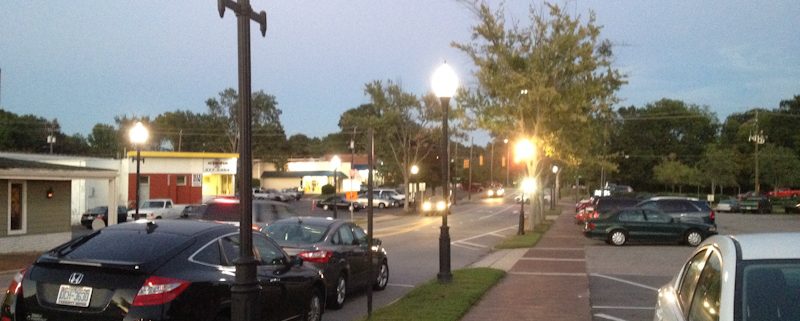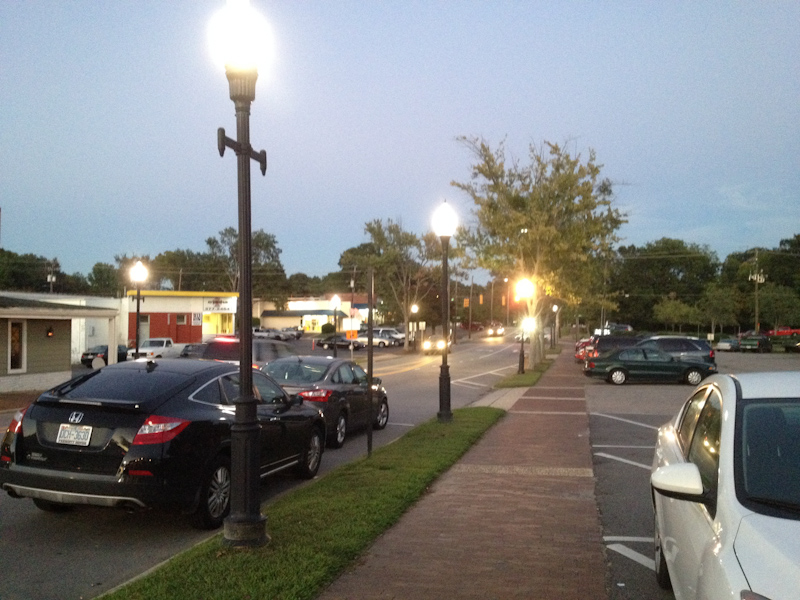Op-Ed: Move Over Cars, Pedestrians Need to Take Back Cary’s Streets
Sarah Wotus, a Cary resident and current student at the University of North Carolina at Chapel Hill majoring in Biostatistics with special interests in Environmental Studies and City Planning, contributed to this op-ed.
Cary, NC – Downtown Cary is revitalizing. By including a variety of stores, entertainment, and living options in the area, it is becoming the community center every town needs. Seeing the popularity of the Downtown Park, city planners are ecstatic for the future. Planners have one part of the design completely wrong though – cars. Cary needs to embrace a future where its residents are not attached to the vehicles currently in their driveways, and there is no better time than now.
Pedestrians are worried their movement throughout the area will be hindered by the increased traffic coming into the area. The city’s solution? Increase on-street parking and add striping to crosswalks to make drivers aware that pedestrians are in the area. Planners did not consider the more sustainable alternative to simply decrease cars. Instead they hold steadfast on the belief that inconveniencing drivers will hurt the economy and liveliness of downtown. Immediately this may be true as the citizens and city structure itself adjust to the new way of living. Planning, though, is all about the future. And Cary’s future must be one that relies less on cars and uses modes of transportation like biking and public transit.
In Cary, there are 1.9 available vehicles per household, 9.6 available vehicles per 10 adults, and only 2.5 percent of households have no vehicles. Not only is this high compared to cities in other developed countries, but Cary also has some of the highest rates in the U.S. according to Governing’s data on car ownership. These statistics are the first indication that Cary’s thinking is outdated. Additionally, research done by the American Public Transportation Association (APTA) shows that investment in public transit is actually better for the economy. For every $1 billion investment in public transportation, 50,000 jobs are created. While a little less than half are jobs pertaining to the industry, the other half are jobs created through productivity effects such as increased household savings, improved employer labor access and reduced congestion. Finally, decreasing car usage is better for environmental, mental and physical health. It improves air quality, increases productivity, allows for more community interactions, and promotes more active lifestyles like walking and biking.
So how? Let’s look at Freiburg, Germany as a model example. After studying renewable energy and city planning there this summer, it is clear the city took a step in the right direction by making it inconvenient to own a car. The first major step concerned the centrally located cathedral. Once just a cathedral surrounded by parking, the city decided to transform the parking lot into a market square where vendors could come every morning to sell their products. Parking was then moved to the outskirts of the city to make room for new public transportation and more walkable streets. Now, with costs anywhere from €30 to 40,000 per year to park, citizens are choosing to walk, bike, use public transportation and start car sharing programs. Freiburg has a rate of about 3.5 cars per 10 adults and has been considered one of Europe’s most sustainable cities for 10 to 15 years.
It’s time to bring these lessons back home. The Raleigh-Cary metropolitan area remains one of the fastest growing areas in the nation, meaning lots of redevelopment to accommodate a large amount of growth and little remaining space to grow. Cary planners are taking this to heart – in the past eight years stretches of Downtown Cary have seen major remodeling with several new businesses, as well as more green space with the Downtown Park. Downtown Development Manager Ted Boyd said it himself: “Given what we’ve done, the second phase needs to be spectacular” (as cited in the Cary Citizen). Cary citizens, let’s make it spectacular by demanding of our city planners that we become a less car-dependent town. It can all start with one small decision to eliminate a parking lot.
Sources
Economic Impact of Public Transportation Investment https://www.apta.com/resources/reportsandpublications/Documents/Economic-Impact-Public-Transportation-Investment-APTA.pdf
Car Ownership in U.S. Cities Map http://www.governing.com/gov-data/car-ownership-numbers-of-vehicles-by-city-map.html
Michael Papich, “Latest Downtown Talk Looks at New Offices, Housing and Possible Train Station”
Sarah Wotus contributed to this op-ed. Photos by Hal Goodtree.





Cary will also be constructing a new multimodal center to replace the existing train station. This new center will include room for additional Amtrak service; new commuter rail; new bus rapid transit; and additional bus bays for more local routes. It will take years to implement these improvements, but the end result will be more travel options so that residents won’t have to drive into downtown.
EVERYTHING Harrison said above! I’m a Cary native who also lived in NYC for 7 years before returning to Cary- I miss the public transportation and walkability of my old city neighborhood, but Cary isn’t and never will be New York (thank goodness!) NYC is dense, compact, and everything you need (or a bus or train to take you there) is within a few blocks of your residence. The TOC has done a great job of making downtown pedestrian-friendly, and I walk there almost everyday. However, as a downtown business owner I know that if there is not accessibility by car for the vast majority of residents who can’t just walk or bike over, my business will suffer and ultimately fail. I live one mile from my shop and I love seeing my neighbors there, but that’s a pretty small customer base and completely unsustainable. AND, even one mile is a lot in the extreme heat or rain, especially with children in tow. If it is not convenient to get somewhere, people (especially seniors, families with small kids, etc.) will find somewhere else to go. Removing parking and/or “taxing” car use (by way of high parking/access fees) will do nothing but impact downtown businesses negatively.
Also meant to end with, if businesses are negatively impacted, they will close, and then where will all the pedestrians go? It’s a chain reaction, just look at what happened to downtown Raleigh when Fayetteville Street was turned into a pedestrian mall (I still remember when it was woefully full of empty storefronts in the 90s) and then converted back into a street where people could once again easily access business. Raleigh has become very pedestrian friendly due in large part to denser housing (like Europe, hey!), but that’s a discussion for another time.
There will be a public bathroom as part of the new library/parking garage complex adjacent to the fountain area. The entire Academy Ave. area is part of a master plan which is being built out over several years. Construction of the library is supposed to be completed Spring of 2019, remaining 7 acre park area will be in design later this year. There is still the Cary Arts Center for bathroom facilities.
There are bathrooms at the Cary Library and the Cary Station that are accessible during business hours.
Accessibility is being able to reach a destination in a reasonable amount of time. Many European cities are much more compact and dense than Cary. The only way for Freiburg to serve as a transportation role model for Cary is if Cary also takes on Freiburg’s land development form. A place doesn’t become walkable just because cars are banned and sidewalks widened – it becomes walkable because development patterns allow walking to provide accessibility equivalent to driving. If I want to have lunch downtown, from my house it’s about an 8 to 10 minute drive or a 50 to 60 minute walk. According to Wikitravel I could walk from one side of Freiburg’s city center in 10 to 15 minutes. At present downtown is reasonably pedestrian accessible to perhaps 1% of Cary residents. Freiburg appears to have thousands of multi-family dwellings in and near the city center. It is very possible to make Cary more pedestrian friendly but it would require near-total redevelopment to make it as pedestrian-oriented as a German city.
I’m a long time transit advocate, which also involves a lot of pedestrian activity getting to and from the bus stop. There are several issues facing pedestrians in the Cary area:
1. Lack of sidewalks to get from home to the bus stop in many areas.
2. Crosswalks at several major intersections are not pedestrian friendly. In fact, they’re downright hazardous. This is being addressed, but there’s a ways to go yet.
3. Cary’s “spoke and wheel” street layout was not designed with pedestrians in mind.
4. Weather – Heat and humidity in the summer. Heat indexes of 90+ are an issue for many seniors, and the very young. Cold and rain, snow, and ice, are a problem in the winter.
5. Bicycles – I’ve lost track of the number of times I’ve be hit, and occasionally knocked down, by an adult riding a bicycle on the sidewalk. Interestingly enough, I’ve never been hit by a child. They seem to remember to ring their bell, or blow their horn, to let you know they’re coming. Bicycles are considered vehicles by NC’s traffic laws. My feeling is if the rider is 16 years old, or older, they should be riding in the streets with the bike lanes and ‘sharrows’.
This assumes DTC is walkable from the surrounding areas, that all people can walk, and there is a desire to go Dowtown. Some of us aging life-long Cary citizens must drive to Ashworths’s for meds. Remove parking…remove people.